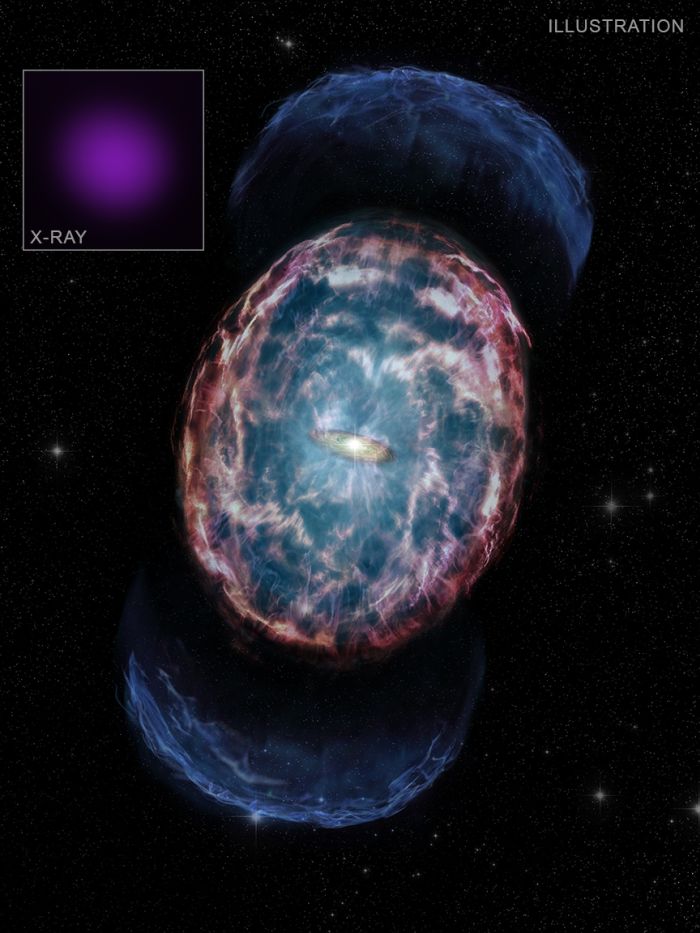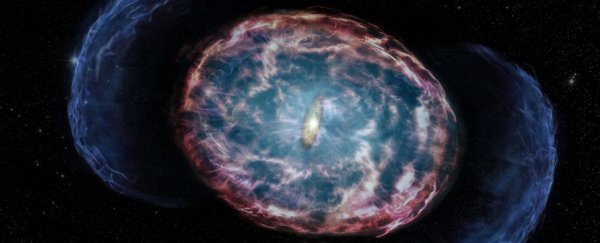A strange X-ray glow seen in the sky three and a half years after an epic collision between two neutron stars is a first for science.
According to astronomers studying the region of space, it could be the afterglow of the kilonova explosion that was generated by the merger, likely produced by a shock wave from the explosion slamming into dust in the region of space around the explosion.
Alternatively, the glow could be produced by material ejected during the explosion falling back down onto the newly merged object, likely a low-mass black hole.
Either way, the phenomenon appears to have never been detected before.
"We have entered uncharted territory here in studying the aftermath of a neutron star merger," says astronomer Aprajita Hajela of Northwestern University.
"We are looking at something new and extraordinary for the very first time. This gives us an opportunity to study and understand new physical processes, which have not before been observed."
The explosion itself, first detected on 17 August 2017, was an absolutely epic event. For the first time, astronomers detected the moment two neutron stars, locked together in an increasingly decaying orbit, had slammed together and merged.
Not only was the event, named GW170817, captured using the new field of gravitational wave astronomy, but in light across the spectrum.
The merger produced a kilonova blast, an explosion 1,000 times brighter than a classical nova. Analysis of the light of this blast revealed that neutron star collisions produce gamma-ray bursts; that near light-speed jets are ejected from the blast; and that, in the energetic environment during the explosion, heavy metals such as gold, platinum, and uranium are formed.
Because this was an entirely new observation, astronomers continued to watch the region of the sky where it occurred, around 132 million light-years from the Solar System.
In X-ray wavelengths, they noticed something really peculiar. Nine days after the gamma-ray burst, the source started to glow across the spectrum, brightening to a peak 160-days post-merger. Then, the glow rapidly faded. This was interpreted as a relativistic jet.
However, while the glow faded across most of the spectrum, from 2020 it plateaued in X-ray wavelengths, a steady light persisting in the darkness of space.
 (X-ray: NASA/CXC/Northwestern Univ./A. Hajela et al.; Illustration: NASA/CXC/M.Weiss)
(X-ray: NASA/CXC/Northwestern Univ./A. Hajela et al.; Illustration: NASA/CXC/M.Weiss)
Above: Artist's impression of the glow from GW170817, with X-ray image inset.
"The fact that the X-rays stopped fading quickly was our best evidence yet that something in addition to a jet is being detected in X-rays in this source," says astrophysicist Raffaella Margutti of the University of California at Berkeley.
"A completely different source of X-rays appears to be needed to explain what we're seeing."
According to the team's analysis, the best fit for the glow is a relativistic shock as ejecta from the collision explodes into space. This, they say, is similar to a sonic boom, here on Earth: as this material expands into the space around the merger, it slams into gas, generating shocks that heat the gas and cause the X-ray glow.
If this is the case, it suggests that the formation of a black hole from the two neutron stars was not a prompt process.
The other explanation is that, when the black hole formed, material around it started falling back onto it, after assembling into a swirling accretion disk. This orbiting disk, heated by gravity and friction, would also emit X-radiation.
Either scenario – a kilonova shock wave or material falling onto a black hole newly formed in a neutron star merger – would be a first.
Astronomers are going to continue to observe it to see how the behavior changes. If it brightens in radio emissions over the next few years, it's likely a shock wave. If it continues steadily and then declines in brightness, it's likely black hole accretion. Whichever it is will tell us something new about neutron star mergers.
"Further study of GW170817 could have far-reaching implications," says astronomer Kate Alexander of Northwestern University.
"The detection of a kilonova afterglow would imply that the merger did not immediately produce a black hole. Alternatively, this object may offer astronomers a chance to study how matter falls onto a black hole a few years after its birth."
The research is due to be published in the latest issue of The Astrophysical Journal Letters, and is available on preprint server arXiv.
